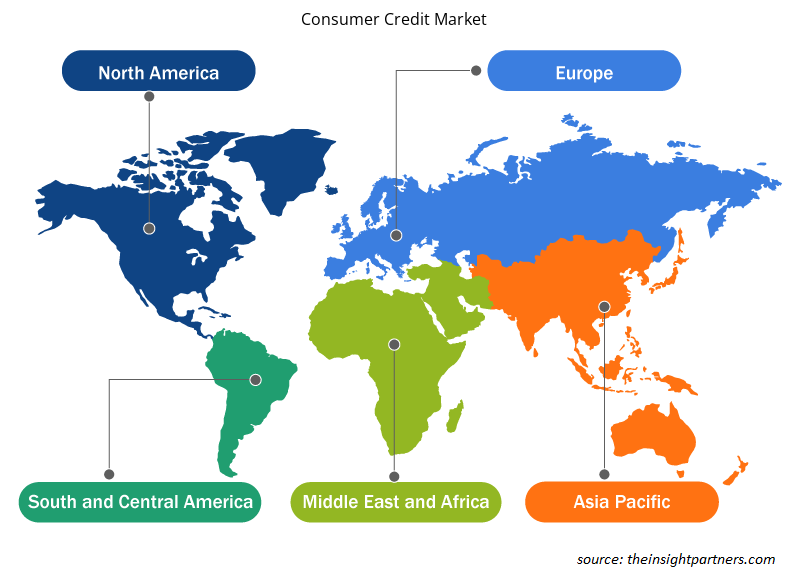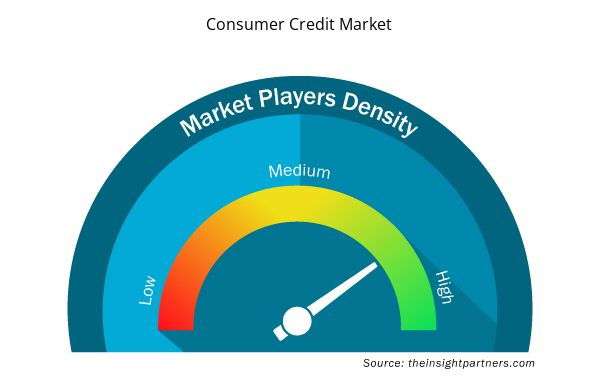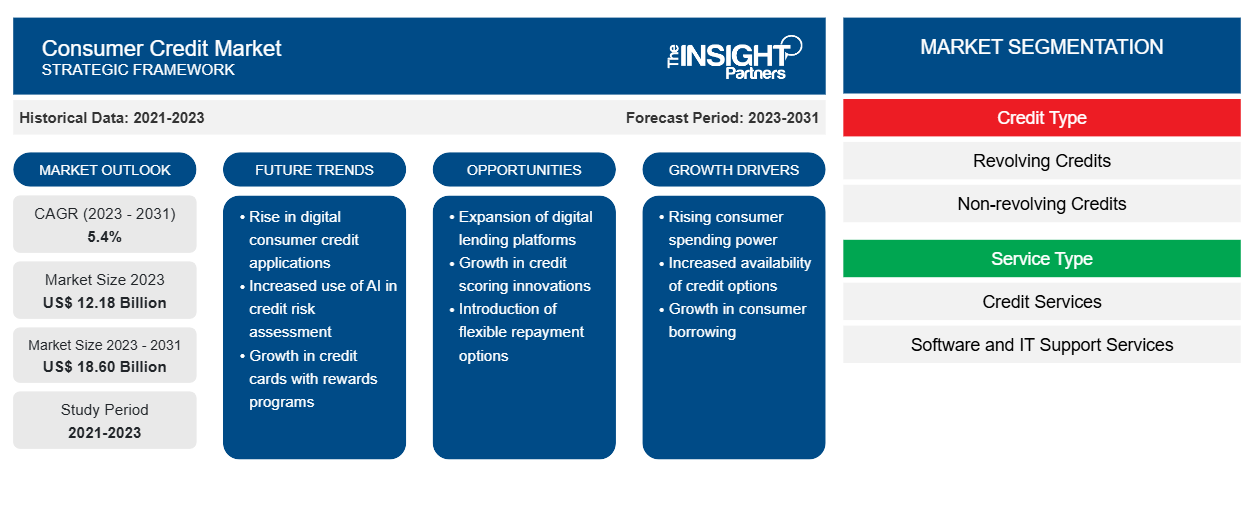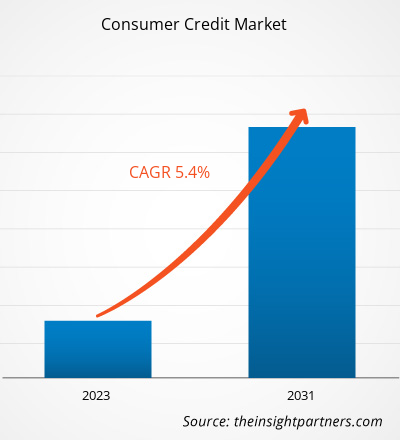Si prevede che le dimensioni del mercato del credito al consumo cresceranno da 12,18 miliardi di $ nel 2023 a 18,60 miliardi di $ entro il 2031; si prevede che si espanderà a un CAGR del 5,4% dal 2023 al 2031. Il credito al consumo, spesso noto come debito al consumo, è un debito personale contratto per acquisire beni o servizi. Sebbene qualsiasi tipo di prestito personale possa essere classificato come credito al consumo, la frase è più comunemente utilizzata per indicare un debito non garantito in piccole somme. Le statistiche sul credito al consumo sono un indice chiave per monitorare la salute di un'economia. Trasmette il potere di spesa di un consumatore in una particolare economia.
Analisi del mercato del credito al consumo
Il credito è un importante abilitatore di consumo per i clienti che altrimenti non sarebbero in grado di permettersi un prodotto particolare. Poiché sempre più persone fanno acquisti online, soluzioni digitali innovative per la finanza al punto vendita, spesso progettate da aziende tecnologiche agili e integrate senza soluzione di continuità nel percorso del cliente, stanno guadagnando popolarità tra gli acquirenti della generazione Y che sono cauti riguardo alle inadeguate capacità digitali delle banche tradizionali. I progressi tecnologici e la regolamentazione di supporto hanno reso più facile per questi nuovi concorrenti interrompere il controllo delle banche tradizionali sulla catena del valore dei prestiti e competere sulla base di una fornitura di servizi più rapida, personalizzata ed efficiente. La lealtà e l'inerzia che in precedenza legavano i consumatori alle loro banche stanno svanendo in tutta Europa, poiché la regolamentazione ha reso più facile che mai creare partnership con diversi fornitori di servizi finanziari.
Credito al consumo
Panoramica del settore
- Alcuni dei principali fattori che guidano la crescita del mercato del credito al consumo sono il cambiamento degli stili di vita urbani, la rapida proliferazione dell'e-commerce in tutte le regioni del mondo, i progressi tecnologici e altri. Ad esempio, l'introduzione dell'intelligenza artificiale cambierà il processo fondamentale del prestito al consumo. La tecnologia AI è progettata per migliorare e semplificare le attività amministrative, consentendo ai dipendenti delle banche di dedicare più tempo alle relazioni con i clienti. Le interazioni basate sull'AI consentono un onboarding dei clienti senza interruzioni e tempi di risposta ridotti per le attività di rischio e conformità. Le esperienze positive dei consumatori possono aumentare la fedeltà e i referral dei clienti.
- L'attività di credito al consumo di un paese dipende in larga misura dal comportamento di spesa di un consumatore nel paese. Ad esempio, la spesa delle carte di credito dei consumatori è aumentata solo del 4,1 percento anno su anno nel 2023 nel Regno Unito, molto al di sotto della crescita osservata nel 2022 (10,6 percento), poiché i britannici hanno ridotto i vestiti nuovi, le cene fuori e i lavori di ristrutturazione della casa a causa della crescente inflazione e dei costi familiari. I consumatori, d'altro canto, hanno continuato a dare priorità ai momenti di piacere e alle esperienze condivise, guidando la crescita nei viaggi, nell'intrattenimento e nei pub e bar.
Personalizza questo report in base alle tue esigenze
Riceverai la personalizzazione gratuita di qualsiasi report, comprese parti di questo report, o analisi a livello nazionale, pacchetto dati Excel, oltre a usufruire di grandi offerte e sconti per start-up e università
- Scopri le principali tendenze di mercato in questo rapporto.Questo campione GRATUITO includerà analisi di dati che spaziano dalle tendenze di mercato alle stime e alle previsioni.
Driver del mercato del credito al consumo
Richiesta di flessibilità nella spesa per guidare il mercato del credito al consumo
- Offrire prestiti al consumo aumenta la conversione offrendo la flessibilità che i clienti di oggi desiderano. Secondo il Millennial Money Survey del Foreign & Colonial Investment Trust, il 16% dei millennial non risparmia denaro ogni mese e 7,8 milioni non hanno alcun risparmio.
- I Millennials spesso danno più valore a esperienze come viaggi, cene fuori e intrattenimento rispetto alla proprietà di beni tradizionali come case e automobili. Di conseguenza, gli individui potrebbero fare più affidamento su carte di credito e prestiti personali per finanziare queste esperienze, alimentando la domanda nel mercato del credito al consumo.
Credito al consumo
Analisi della segmentazione del rapporto di mercato
- In base alla tipologia di credito, il rapporto sul mercato del credito al consumo è suddiviso in crediti revolving e crediti non revolving.
- Il credito revolving, che include le carte di credito, può essere utilizzato per qualsiasi acquisto. Il credito è "revolving" nel senso che la linea di credito rimane aperta e può essere utilizzata fino al limite massimo ripetutamente, finché il mutuatario continua a effettuare puntualmente il pagamento mensile minimo.
Credito al consumo
Analisi di mercato per area geografica
L'ambito del rapporto sul mercato del credito al consumo è principalmente suddiviso in cinque regioni: Nord America, Europa, Asia Pacifico, Medio Oriente e Africa e Sud America. Il Nord America sta vivendo una rapida crescita e si prevede che detenga una quota significativa del mercato del credito al consumo. Il significativo sviluppo economico della regione, la crescita della popolazione e la crescente attenzione alla gestione del rischio e all'assicurazione hanno contribuito a questa crescita. Il Nord America ospita molti paesi in via di sviluppo come gli Stati Uniti e il Canada, che guidano la crescita del mercato del credito al consumo.
Credito al consumo
Approfondimenti regionali sul mercato del credito al consumo
Le tendenze regionali e i fattori che influenzano il mercato del credito al consumo durante il periodo di previsione sono stati ampiamente spiegati dagli analisti di Insight Partners. Questa sezione discute anche i segmenti e la geografia del mercato del credito al consumo in Nord America, Europa, Asia Pacifico, Medio Oriente e Africa, e Sud e Centro America.

- Ottieni i dati specifici regionali per il mercato del credito al consumo
Ambito del rapporto sul mercato del credito al consumo
| Attributo del report | Dettagli |
|---|---|
| Dimensioni del mercato nel 2023 | 12,18 miliardi di dollari USA |
| Dimensioni del mercato entro il 2031 | 18,60 miliardi di dollari USA |
| CAGR globale (2023-2031) | 5,4% |
| Dati storici | 2021-2023 |
| Periodo di previsione | 2023-2031 |
| Segmenti coperti | Per tipo di credito
|
| Regioni e Paesi coperti | America del Nord
|
| Leader di mercato e profili aziendali chiave |
|
Densità degli operatori del mercato del credito al consumo: comprendere il suo impatto sulle dinamiche aziendali
Il mercato del credito al consumo sta crescendo rapidamente, spinto dalla crescente domanda degli utenti finali dovuta a fattori quali l'evoluzione delle preferenze dei consumatori, i progressi tecnologici e una maggiore consapevolezza dei vantaggi del prodotto. Con l'aumento della domanda, le aziende stanno ampliando le loro offerte, innovando per soddisfare le esigenze dei consumatori e capitalizzando sulle tendenze emergenti, il che alimenta ulteriormente la crescita del mercato.
La densità degli operatori di mercato si riferisce alla distribuzione di aziende o società che operano in un particolare mercato o settore. Indica quanti concorrenti (operatori di mercato) sono presenti in un dato spazio di mercato in relazione alle sue dimensioni o al valore di mercato totale.
Le principali società che operano nel mercato del credito al consumo sono:
- American Express
- Banca degli Stati Uniti
- Città
- Banca Wells Fargo
- Banca Capitale Uno
Disclaimer : le aziende elencate sopra non sono classificate secondo un ordine particolare.

- Ottieni una panoramica dei principali attori del mercato del credito al consumo
"Analisi del mercato del credito al consumo"è stato condotto in base alle strategie di investimento principali e alla geografia. In termini di tipo di credito, il mercato è segmentato in crediti revolving e crediti non revolving. In base alla geografia, il mercato è segmentato in Nord America, Europa, Asia Pacifico, Medio Oriente e Africa e Sud America.
Credito al consumo
Notizie di mercato e sviluppi recenti
Le aziende adottano strategie inorganiche e organiche come fusioni e acquisizioni nel mercato del credito al consumo. Di seguito sono elencati alcuni recenti sviluppi chiave del mercato:
- A febbraio 2024, Barclays PLC e Blackstone Credit & Insurance hanno annunciato oggi che Barclays Bank Delaware ha stipulato un accordo con conti assicurativi gestiti dal gruppo Asset Based Finance di Blackstone per vendere circa 1,1 miliardi di dollari USA di crediti da carte di credito attualmente in sospeso in relazione a un set definito di conti di carte di credito a marchio Barclays negli Stati Uniti d'America. Questa è la prima di una serie di attività che Barclays prevede di condurre per ridurre i suoi asset ponderati per il rischio (RWA) e creare ulteriore capacità di prestito per BBDE.
[Fonte: Barclays PLC, sito web aziendale]
Credito al consumo
Copertura e risultati del rapporto di mercato
Il rapporto di mercato "Dimensioni e previsioni del mercato del credito al consumo (2021-2031)" fornisce un'analisi dettagliata del mercato che copre le seguenti aree:
- Dimensioni e previsioni del mercato a livello globale, regionale e nazionale per tutti i principali segmenti di mercato interessati dall'indagine.
- Dinamiche di mercato quali fattori trainanti, limitazioni e opportunità chiave.
- Principali tendenze future.
- Analisi PEST e SWOT dettagliate
- Analisi del mercato globale e regionale che copre le principali tendenze del mercato, gli attori chiave, le normative e i recenti sviluppi del mercato.
- Analisi del panorama industriale e della concorrenza che comprende la concentrazione del mercato, l'analisi della mappa di calore, gli attori chiave e gli sviluppi recenti.
- Profili aziendali dettagliati.
- Analisi storica (2 anni), anno base, previsione (7 anni) con CAGR
- Analisi PEST e SWOT
- Valore/volume delle dimensioni del mercato - Globale, regionale, nazionale
- Industria e panorama competitivo
- Set di dati Excel



Report Coverage
Revenue forecast, Company Analysis, Industry landscape, Growth factors, and Trends

Segment Covered
This text is related
to segments covered.

Regional Scope
North America, Europe, Asia Pacific, Middle East & Africa, South & Central America

Country Scope
This text is related
to country scope.
Domande frequenti
The global consumer credit market was estimated to be US$ 12.18 billion in 2023 and is expected to grow at a CAGR of 5.4% during the forecast period 2023 - 2031.
The use of AI and data analytics is impacting consumer credit, which is anticipated to bring new consumer credit market trends in the coming years.
The key players holding majority shares in the global Consumer Credit market are American Express, U.S. Bank, Citi, and Wells Fargo Bank.
The global consumer credit market is expected to reach US$ 18.60 billion by 2031.
Demand for flexibility in spending and rapid urbanization are the major factors that propel the global consumer credit market growth.
Trends and growth analysis reports related to Banking, Financial Services, and Insurance : READ MORE..
- American Express
- U.S. Bank
- Citi
- Wells Fargo Bank
- Capital One Bank
- Revolut
- Barclays
- Discover
- Finastra
- Affirm
The Insight Partners performs research in 4 major stages: Data Collection & Secondary Research, Primary Research, Data Analysis and Data Triangulation & Final Review.
- Data Collection and Secondary Research:
As a market research and consulting firm operating from a decade, we have published and advised several client across the globe. First step for any study will start with an assessment of currently available data and insights from existing reports. Further, historical and current market information is collected from Investor Presentations, Annual Reports, SEC Filings, etc., and other information related to company’s performance and market positioning are gathered from Paid Databases (Factiva, Hoovers, and Reuters) and various other publications available in public domain.
Several associations trade associates, technical forums, institutes, societies and organization are accessed to gain technical as well as market related insights through their publications such as research papers, blogs and press releases related to the studies are referred to get cues about the market. Further, white papers, journals, magazines, and other news articles published in last 3 years are scrutinized and analyzed to understand the current market trends.
- Primary Research:
The primarily interview analysis comprise of data obtained from industry participants interview and answers to survey questions gathered by in-house primary team.
For primary research, interviews are conducted with industry experts/CEOs/Marketing Managers/VPs/Subject Matter Experts from both demand and supply side to get a 360-degree view of the market. The primary team conducts several interviews based on the complexity of the markets to understand the various market trends and dynamics which makes research more credible and precise.
A typical research interview fulfils the following functions:
- Provides first-hand information on the market size, market trends, growth trends, competitive landscape, and outlook
- Validates and strengthens in-house secondary research findings
- Develops the analysis team’s expertise and market understanding
Primary research involves email interactions and telephone interviews for each market, category, segment, and sub-segment across geographies. The participants who typically take part in such a process include, but are not limited to:
- Industry participants: VPs, business development managers, market intelligence managers and national sales managers
- Outside experts: Valuation experts, research analysts and key opinion leaders specializing in the electronics and semiconductor industry.
Below is the breakup of our primary respondents by company, designation, and region:

Once we receive the confirmation from primary research sources or primary respondents, we finalize the base year market estimation and forecast the data as per the macroeconomic and microeconomic factors assessed during data collection.
- Data Analysis:
Once data is validated through both secondary as well as primary respondents, we finalize the market estimations by hypothesis formulation and factor analysis at regional and country level.
- Macro-Economic Factor Analysis:
We analyse macroeconomic indicators such the gross domestic product (GDP), increase in the demand for goods and services across industries, technological advancement, regional economic growth, governmental policies, the influence of COVID-19, PEST analysis, and other aspects. This analysis aids in setting benchmarks for various nations/regions and approximating market splits. Additionally, the general trend of the aforementioned components aid in determining the market's development possibilities.
- Country Level Data:
Various factors that are especially aligned to the country are taken into account to determine the market size for a certain area and country, including the presence of vendors, such as headquarters and offices, the country's GDP, demand patterns, and industry growth. To comprehend the market dynamics for the nation, a number of growth variables, inhibitors, application areas, and current market trends are researched. The aforementioned elements aid in determining the country's overall market's growth potential.
- Company Profile:
The “Table of Contents” is formulated by listing and analyzing more than 25 - 30 companies operating in the market ecosystem across geographies. However, we profile only 10 companies as a standard practice in our syndicate reports. These 10 companies comprise leading, emerging, and regional players. Nonetheless, our analysis is not restricted to the 10 listed companies, we also analyze other companies present in the market to develop a holistic view and understand the prevailing trends. The “Company Profiles” section in the report covers key facts, business description, products & services, financial information, SWOT analysis, and key developments. The financial information presented is extracted from the annual reports and official documents of the publicly listed companies. Upon collecting the information for the sections of respective companies, we verify them via various primary sources and then compile the data in respective company profiles. The company level information helps us in deriving the base number as well as in forecasting the market size.
- Developing Base Number:
Aggregation of sales statistics (2020-2022) and macro-economic factor, and other secondary and primary research insights are utilized to arrive at base number and related market shares for 2022. The data gaps are identified in this step and relevant market data is analyzed, collected from paid primary interviews or databases. On finalizing the base year market size, forecasts are developed on the basis of macro-economic, industry and market growth factors and company level analysis.
- Data Triangulation and Final Review:
The market findings and base year market size calculations are validated from supply as well as demand side. Demand side validations are based on macro-economic factor analysis and benchmarks for respective regions and countries. In case of supply side validations, revenues of major companies are estimated (in case not available) based on industry benchmark, approximate number of employees, product portfolio, and primary interviews revenues are gathered. Further revenue from target product/service segment is assessed to avoid overshooting of market statistics. In case of heavy deviations between supply and demand side values, all thes steps are repeated to achieve synchronization.
We follow an iterative model, wherein we share our research findings with Subject Matter Experts (SME’s) and Key Opinion Leaders (KOLs) until consensus view of the market is not formulated – this model negates any drastic deviation in the opinions of experts. Only validated and universally acceptable research findings are quoted in our reports.
We have important check points that we use to validate our research findings – which we call – data triangulation, where we validate the information, we generate from secondary sources with primary interviews and then we re-validate with our internal data bases and Subject matter experts. This comprehensive model enables us to deliver high quality, reliable data in shortest possible time.


 Ottieni un campione gratuito per questo repot
Ottieni un campione gratuito per questo repot